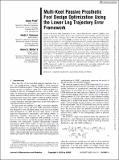Multi-Keel Passive Prosthetic Foot Design Optimization Using the Lower Leg Trajectory Error Framework
Author(s)
Prost, Victor; Peterson, Heidi V; Winter V, Amos G
DownloadPublished version (843.9Kb)
Publisher Policy
Publisher Policy
Article is made available in accordance with the publisher's policy and may be subject to US copyright law. Please refer to the publisher's site for terms of use.
Terms of use
Metadata
Show full item recordAbstract
People with lower-limb amputation in low- and middle-income countries (LMICs) lack access to adequate prosthetic devices that would restore their mobility and increase their quality of life. This is largely due to the cost and durability of existing devices. Single-keel energy storage and return (ESR) prosthetic feet have recently been developed using the lower leg trajectory error (LLTE) design framework to provide improved walking benefits at an affordable cost in LMICs. The LLTE framework optimizes the stiffness and geometry of a user’s prosthesis to match a target walking pattern by minimizing the LLTE value, a measure of how closely a prosthetic foot replicates a target walking pattern. However, these low-cost single-keel prostheses do not provide the required durability to fulfill International Standards Organization (ISO) testing, preventing their widespread use and adoption. Here, we developed a multi-keel foot parametric model and extended the LLTE framework to include the multi-keel architecture and durability requirements. Multi-keel designs were shown to provide 76% lower LLTE values, compared with single-keel designs while withstanding ISO fatigue and static tests, validating their durability. Given their single-part 2D extruded geometries, multi-keel feet designed with the extended LLTE framework could be cost-effectively manufactured, providing affordable and durable high-performance prostheses that improve the mobility of LMIC users.
Date issued
2023-08-01Department
Massachusetts Institute of Technology. Department of Mechanical EngineeringJournal
Journal of Mechanisms and Robotics
Publisher
ASME International
Citation
Prost, Victor, Peterson, Heidi V and Winter V, Amos G. 2023. "Multi-Keel Passive Prosthetic Foot Design Optimization Using the Lower Leg Trajectory Error Framework." Journal of Mechanisms and Robotics, 15 (4).
Version: Final published version